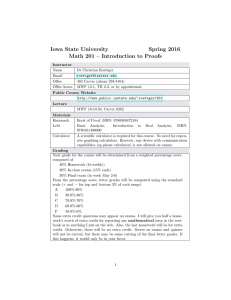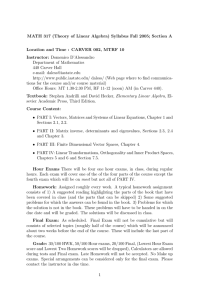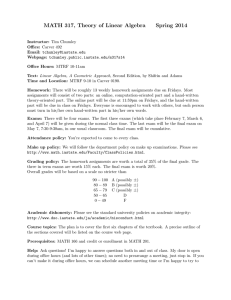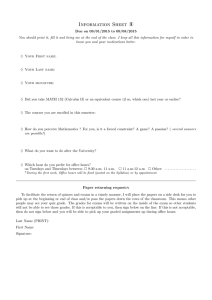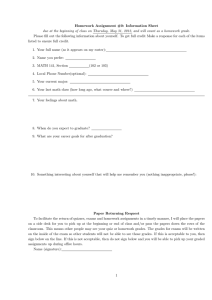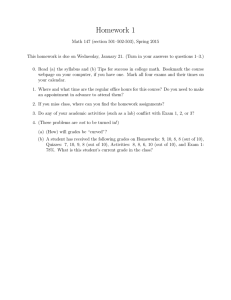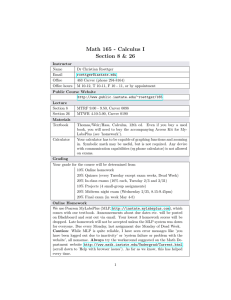Iowa State University Spring 2016 Math 105 – Introduction to Mathematical Ideas
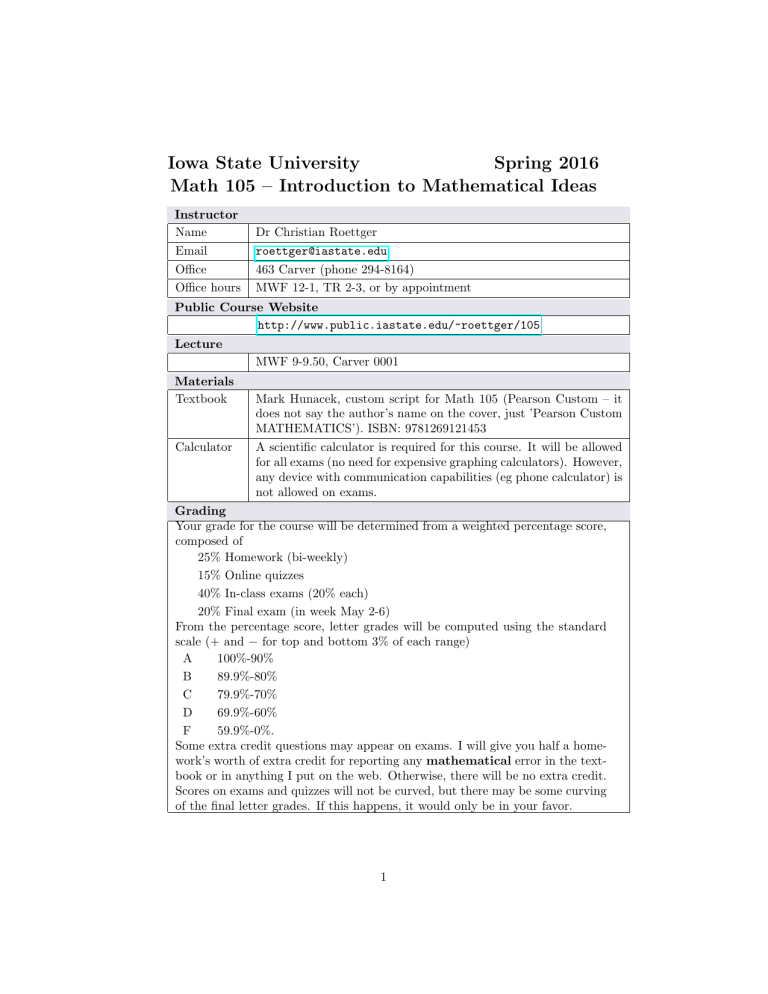
Iowa State University Spring 2016
Math 105 – Introduction to Mathematical Ideas
Instructor
Name Dr Christian Roettger
Office roettger@iastate.edu
463 Carver (phone 294-8164)
Office hours MWF 12-1, TR 2-3, or by appointment
Public Course Website http://www.public.iastate.edu/~roettger/105
Lecture
MWF 9-9.50, Carver 0001
Materials
Textbook
Calculator
Mark Hunacek, custom script for Math 105 (Pearson Custom – it does not say the author’s name on the cover, just ’Pearson Custom
MATHEMATICS’). ISBN: 9781269121453
A scientific calculator is required for this course. It will be allowed for all exams (no need for expensive graphing calculators). However, any device with communication capabilities (eg phone calculator) is not allowed on exams.
Grading
Your grade for the course will be determined from a weighted percentage score, composed of
25% Homework (bi-weekly)
15% Online quizzes
40% In-class exams (20% each)
20% Final exam (in week May 2-6)
From the percentage score, letter grades will be computed using the standard scale (+ and − for top and bottom 3% of each range)
A 100%-90%
B
C
89.9%-80%
79.9%-70%
D 69.9%-60%
F 59.9%-0%.
Some extra credit questions may appear on exams. I will give you half a homework’s worth of extra credit for reporting any mathematical error in the textbook or in anything I put on the web. Otherwise, there will be no extra credit.
Scores on exams and quizzes will not be curved, but there may be some curving of the final letter grades. If this happens, it would only be in your favor.
1
Quizzes
Weekly except for exam weeks. Will be posted on Blackboard on Tuesdays and taken online. You will have until the following Friday to take each quiz. Last quiz due on Friday of Dead Week. Your lowest 2 quiz scores will be dropped.
Homework
Bi-weekly written assignments, handed in for grading on Monday BEFORE class. The assignments and due dates will be announced in class and posted on Blackboard. Late homework (including after class) only accepted for half credit. Your lowest 2 homework scores will be dropped.
Exams
There will be 3 exams. Exam 1 and 2 will be 50 minutes, in the usual classroom during the usual class time, on Wednesday 2/10 and 3/30. The Final Exam will be in the week May 2-6, as scheduled by the Registrar. If you miss an exam for any valid reason, you MUST contact me in writing beforehand. Otherwise do not expect to get a makeup exam.
Course description
Topics from mathematics and mathematical applications with emphasis on their nontechnical content. For details, see ’Course Objectives’. 3 credits. Credits earned in Math 105 cannot be applied toward graduation by math majors.
Prerequisites
Satisfactory performance on placement exam, 2 years of high school algebra, 1 year of geometry.
Additional resources
TA hours office J Mandl mandl@iastate.edu
, Carver 465, M 1-3, Tue 1-2, Thu 1-2
Blackboard For homework, announcements, all scores and grades
Departmental course page
Course description, objectives, policies.
http://orion.math.iastate.edu/dept/CoursePages/105/
Classroom policies
We do not take attendance. However, you should be aware that students who attend class regularly score much better on tests and get better grades. You are responsible for reading the relevant section of the script.
Please note that anybody found cheating on an exam may be awarded a score of zero on that exam, or even an F for the entire course depending on circumstances.
For the benefit of everyone, please do not use cellphones during class.
The policies below are also in full effect. These policies govern makeup exams, disability accommodations, discrimination/harrassment, religious accommodations, and much more. Feel free to ask me for more details!
Departmental http://www.math.iastate.edu/Faculty/ClassPolicies.html
Make-up exams http://catalog.iastate.edu/academiclife/regulations
2
Course Objectives / Learning Outcomes
• Understanding the basic methods and limitations of preference voting methods
• Understanding the basic methods of yes-no voting and the assessment of power in such a voting system
• Understanding the basic ideas of apportionment and fair division
• Understanding the basic ideas of game theory
For more details, see the departmental course page above.
3
